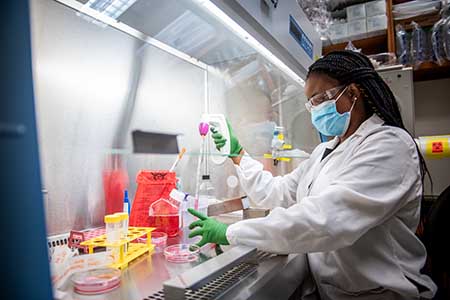Cellular communication
By Katie Messerla
 Tshegofatso Ngwaga likes to communicate with cells. Cells in the immune system, to be more specific.
Tshegofatso Ngwaga likes to communicate with cells. Cells in the immune system, to be more specific.
Her current project seeks to characterize mechanisms that the host immune system uses to combat Legionella pneumophila, the causative agent of Legionnaires’ disease.
“I study how this bacterium uses its arsenal of more than 300 effector proteins to manipulate the host and evade host cellular defenses,” said Ngwaga, doctoral student in biology in the Kansas State University College of Arts and Sciences.
Her research with Legionella effectors — or virulence proteins — is contributing to the growing knowledge of how the human immune system detects pathogenic bacteria. The work helps researchers learn additional ways that immune cells restrict intracellular pathogens like Legionella pneumophila.
“This research is important because most cellular processes and the function of most cellular components were discovered through studying how pathogens manipulate those processes,” Ngwaga said. “I hope my research contributes to the development of new therapeutic strategies that do not rely on the use of antibiotics to fight infectious pathogens.”
Ngwaga works as a research assistant with Stephanie Shames, assistant professor in the Division of Biology.
“Tshego is leading an exciting project on how bacterial virulence proteins that are required for intracellular replication can paradoxically aid in immune detection of the pathogen,” Shames said. “She has made excellent progress and is in the process of preparing her second primary research manuscript on this subject.”
Ngwaga won first place in the graduate poster presentation category at this year’s joint meeting of the Missouri and Missouri Valley branches of the American Society for Microbiology.